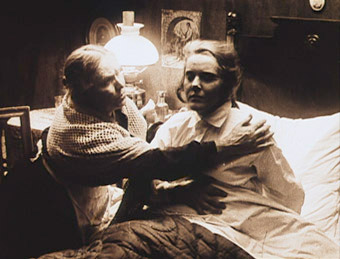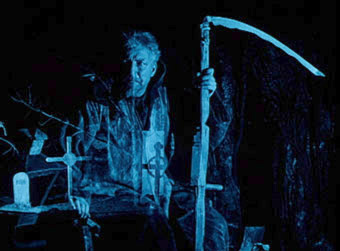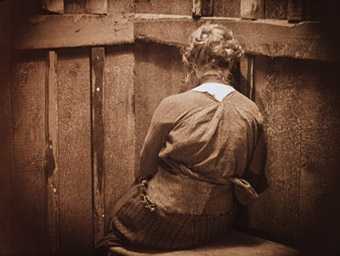|
Tartan Video has simultaneously released two versions of The Phantom Carriage on UK DVD. The version covered here if the KTL Edition, a single disc release with a new soundtrack by the experimental band KTL. The film is also available with a more traditional score as part of a 2-disc set with Ingmar Berman's The Image Makers, which is reviewed here. The film itself is reviewed below and the comments apply equally to both versions, as do the picture details. The differences in the soundtrack and how it affects your reading of the film are covered separately in each review.
As reviewers, we like to pretend that we take a fair and balanced approach to any film that we cover and claim that what we say is not a matter of opinion, but hard fact. It never is. When a reviewer, any reviewer, claims that a film is bad, for example, it just means they didn't like it, and that can be for a whole slew of reasons that are as much about that reviewer as they are about the film. So probably the only fair thing to do is to be open about your prejudices from the start and, if possible, try to see beyond them. After all, is Ismaël Ferroukhi's 2004 Le Grand Voyage really about a devout but ageing Muslim's determination to make a pilgrimage to Mecca before he dies, or the healing of long-ago inflicted relationship wounds between himself and his son? I know, it's about both, but I found it surprisingly easy to tolerate the former, which includes beliefs and behaviour I am not sympathetic to in order to appreciate of the considerable strengths of the latter. It's in this spirit that those of us with an aversion to the piety of religion and its messengers would do best to look upon Victor Sjöström's 1921 The Phantom Carriage [Körkarlen] as a story of a cruel and uncaring man who is given cause to reflect on his life and realise the error of his ways, and turn a blind eye to the fact that he does so by finding God through the self-sacrifice of an angelic Salvation Army worker.

The Phantom Carriage is one of those films that I knew little about until the announcement of its UK DVD release, prompting me to research it and wonder just why it had so far escaped my attention. An acknowledged classic of Swedish silent cinema, it was a favourite film of Ingmar Bergman, on whose work it had clear influence and who paid tribute to it in 2000 with his TV film The Image Makers, which is included as a logical companion piece in Tartan's alternative, 2-disc release of Sjöström's film. Peppered with imagery and ideas that would sit well in a horror tale, its story-within-a-story structure is more complex than most of us are used to seeing in a film of this vintage. It's these elements that help transform what could easily have played as simplistic melodrama into a more layered and intriguing work, one whose story details are not laid out at the start but emerge gradually as the narrative strands and their relationships to each other unfold.
It all begins on New Year's Eve with Salvation Army sister Edit on her death bed in the final stages of raging consumption, her ageing mother at her bedside and fellow Salvation Army sister Maria in attendance. When Edit regains consciousness, she asks for only one thing, that a man named David Holm (played by director Sjöström) be brought to her bedside. We don't know why and won't for some considerable time to come.
Maria dutifully goes in search of David but finds only his forlorn wife, sitting in a corner at home with her back to her two sleeping children in a shot whose overpowering sense of isolated despair sent shivers down my spine. She brings her to Edit's bedside in David's place, and a further layer of intrigue is added when this sorrowful woman makes moves to strangle the dying Edit, only to have her wake and shower the visitor with joyful kisses.
David, meanwhile, is drinking in a graveyard with two friends and ready to toast in the fast approaching new year. While they wait, David tells his companions a story about his friend George, a jovial fellow whose mood would darken considerably each New Year's Eve. Flashback to a year earlier and we get to see for ourselves, first George the energetic fun-lover then George the troubled non-communicator, lying alone on his bed while his friends drink and play cards as they await the dawn of another year. When the card game turns into a fight, George snaps out of his self-absorbed gloom to break it up, telling the men of the dangers that lie in wait every New Year's Eve, when the last person to die before midnight will become the driver of Death's cart for the next twelve months.
It's in the sequences that follow that the film's fame as a visual masterwork is first evident, as the solemn duties of the driver of the phantom cart are illustrated with the aid of the 1920s equivalent of CGI, double-exposures done in camera by winding back the film and re-shooting over the already exposed footage, with only a few careful light calculations and a degree of faith to convince you that you haven't ruined two otherwise perfectly good shots. The results have an unnerving sense of the supernatural, the half-formed image of the cart travelling along dark roads, through ocean waves and even underwater to deliver its driver to doomed individuals as they reach their moment of death, whether it be from illness, old age or suicide. Returning to the here and now, David reveals that George died on this very night one year earlier, then gets into a fight with his companions that ends in them accidentally killing him. As his spirit rises from his lifeless body, Death's cart arrives to collect him with George as its driver. There's just one thing – David is his last customer this fateful evening and it is thus his turn to drive the cart for the year to come.

What sounds like a final twist in the tale is actually the conclusion of set-up for the main story, in which George takes David on a journey through his life's mistakes and the cruelty he has inflicted on others, actions that George blames himself for – "You would have led a good life," he assures him, "had you not fallen in with me." Once again, the narrative moves back in time, gradually clarifying the link between David and Edit and the meaning and purpose of her deathbed plea. Inevitably, George and David's spiritual wanderings though past and present recall Dickens' A Christmas Carol, but also prefigure Capra's It's a Wonderful Life, particularly in the lessons learned and redemptive journey taken.*
The character roles are over-simplified – drunks are heartless and bad, Salvation Army sisters are saintly and selfless – but this is pretty much standard going for the period and would be churlish to hold against a film that is in other ways thrillingly ahead of the game. Although most widely celebrated for Julius Jaenzon's haunting cinematography and double-exposure work, it's the film's assured structure that commands the most respect, taking full advantage of the storytelling capabilities of cinema at a time when narratives were primarily uncomplicated and told in resolutely linear fashion. But it seems only right that a story that was admired in part for the poetry of its writing should be visually realised by a film whose greatness is defined by the compelling and imaginative manner of its telling.
For many years I've argued that the further you go back into film history the more allowances you have to make for print quality, but recently the bar has been seriously raised by the extraordinary work being done by Germany's F.W. Murnau-Stifftung company and the likes of Criterion in America. All of which can, of course, be a bit unfair on those without the same resources and expertise at their disposal. The Phantom Carriage is not up there with some of the more remarkable remasterings of late, but has clearly undergone restoration – the picture is stable, detail is good, the contrast is generally impressive and the image is cleaner than many films of this period. There is some variation in those contrast levels, some occasional shimmering on patterned areas (wallpaper is the main culprit here), and enough dust there to remind you of the film's age, but on the whole this is a rather pleasing job for a film of this vintage. The image is slightly windowboxed on all sides to allow for TV overscan.
Tartan have released The Phantom Carriage in two versions, one with a more traditional silent movie score and this one, which features a new soundtrack by KTL, a band specialising in splendidly dark experimental music and consisting of musicians Stephen O'Malley of Sun O))) and Peter Rehbergh, who previously recorded under the name Pita. I owe my too-recent exposure to their work to our resident musician and fellow reviewer Lord Summerisle and have since become hooked on the twisted ambience of their first CD – if you ever find yourself feeling a bit too carefree, then five minutes of exposure to any of the four title tracks from their Forest Floor album in a dark room should sort that out. The blend of electronic wails, unsettling chords, nervously scratched notes and steadily hammered percussion that drives the score here is very much from the same stable, and as an experimental musical piece in its own right is compelling and disturbing, just as it should be for such a work. There are moments in the film where the score intensifies the sense of unease to the point of surrealistic terror, and the two make for a semi-hallucinatory darkened room experience that's not for the faint-hearted.

But I still have reservations. As a musical piece it is extraordinary, and wedded to the film's striking imagery it transforms some sequences into gallery pieces, but it has clearly been designed as an accompaniment rather than a score in anything approaching the traditional sense. The music rarely acknowledges any of the film's variations in mood and gives even the quietest moments a strong sense of sinister, suggesting that apocalyptic death awaits just outside the borders of every frame. Which is fine for a while and fascinating as an artistic experience, but effectively robs of the film of its tonal variance, emotionally levelling it in a manner that was likely never Sjöström's intent. It goes without saying that if you're not in tune with the KTL approach you're probably going to find this particular score monotonous in the extreme.
Sonically it's close to perfect. Although PCM 2.0 rather than 5.1, the clarity, range and (especially) bass are all superb, and if you run your lower frequencies through the subwoofer then get ready for complaints from the neighbours.
None included on the preview disc, although the release disc does include film notes by The Brothers Quay, who I have no doubt are fans of both the film and the score.
A tricky call. A remarkable film is provided with a powerful musical accompaniment, but one that will alter your perception of the film in a way that makes the story and characters seem less important than the mood and the imagery. If you're looking to enjoy the film for those elements then go for the version twinned with Bergman's The Image Makers, also released by Tartan this week. But if you're looking for an unsettling but arresting artistic experience, then dive right in with Sjöström and KTL.
* In a similar, forward-looking vein, I can't be the only one who watched the scene in which David uses an axe to break through a door separating him from his terrified wife and young children who was reminded of a particularly famous scene in Kubrick's The Shining. Which was also adapted from a respected novel, of course.
|